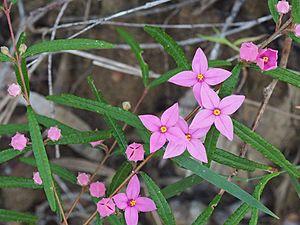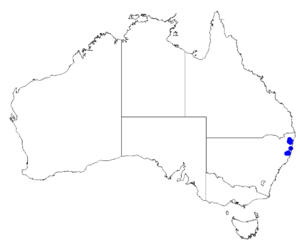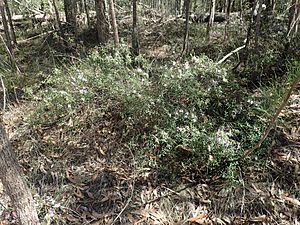Boronia chartacea facts for kids
Quick facts for kids Boronia chartacea |
|
|---|---|
 |
|
| Boronia chartacacea in Fortis Creek National Park | |
| Scientific classification | |
 |
|
| Occurrence data from Australasian Virtual Herbarium |
Boronia chartacea is a special plant found only in Australia. It belongs to the citrus family, just like oranges and lemons! This plant is a shrub, which means it's a bushy plant. You can only find it in one specific area: the north coast of New South Wales. It has simple, papery leaves and pretty bright pink flowers. These flowers usually grow one by one where a leaf meets the stem.
What Does It Look Like?
Boronia chartacea is a shrub that can grow from about 0.4 to 2.7 meters (1.3 to 8.9 feet) tall. Its young branches are a bit hairy. The leaves feel like paper and are shaped like an oval or a long rectangle. They are about 20 to 50 millimeters (0.8 to 2 inches) long and 2 to 4 millimeters (0.08 to 0.16 inches) wide. Each leaf sits on a small stem called a petiole, which is about 1 to 2 millimeters long.
The leaves have small, bumpy glands on them. Their edges are often curled downwards or rolled under. The flowers are a bright pink color. They usually grow alone, but sometimes you can find up to three flowers together. Each flower has a small stalk that is 1 to 8 millimeters long.
Each flower has four egg-shaped sepals. These are small leaf-like parts that protect the flower bud. They are about 2 to 3.5 millimeters long and are hairy on the bottom. The four bright pink petals are longer, about 7 to 9 millimeters long. This plant blooms, or flowers, from August to October. After flowering, it produces a smooth fruit called a capsule.
How It Got Its Name
The plant Boronia chartacea was first officially described in 1990. This description was made by a scientist named Peter H. Weston. He wrote about it in a science journal called Telopea. The plant he studied was found near a town called Urunga.
The second part of its name, chartacea, comes from a Latin word. This word means "of paper." It was chosen because the plant's leaves are thin and feel like paper. They can also become brittle, or easily broken, when they dry out.
Where It Lives
This special boronia plant grows in wet areas. You can often find it in damp gullies or close to creeks. It lives in separate groups of plants, not all in one big area. These groups are found near the towns of Wauchope, Urunga, and Grafton in New South Wales.


